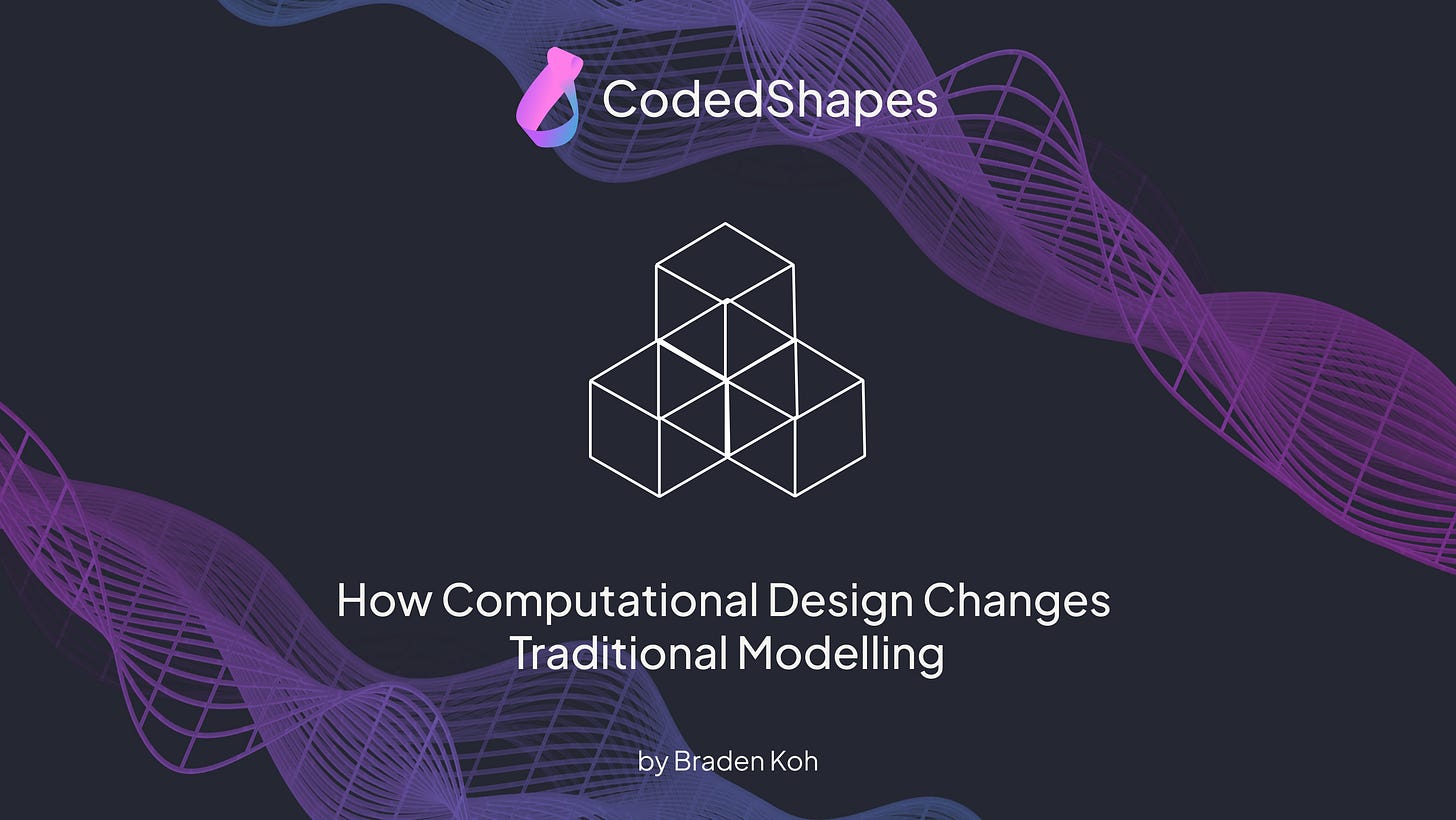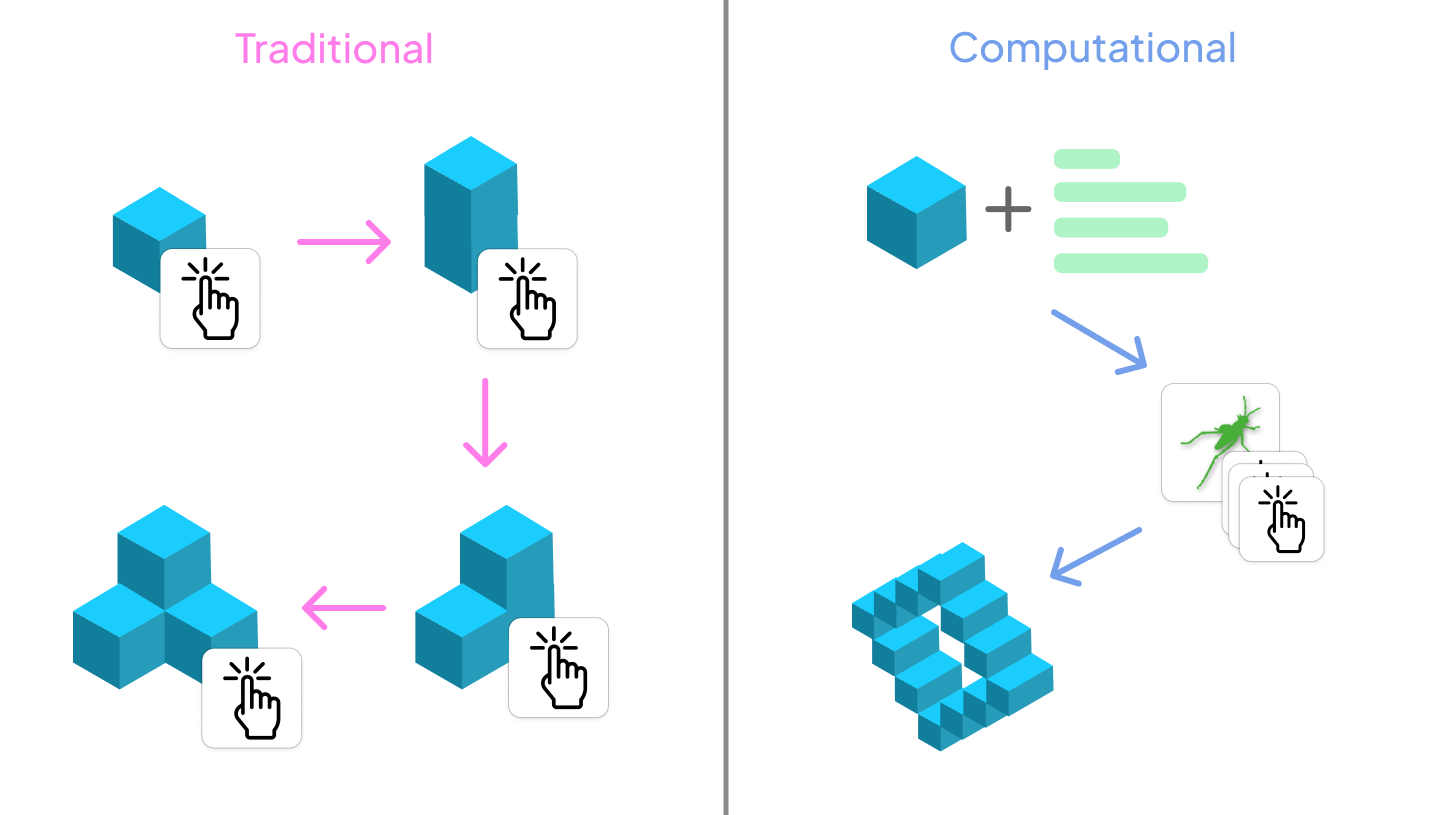How Computational Design Changes Traditional Modelling
Don't model, tell the computer how to model
The methods that create 3D models make a significant difference in the efficiency and quality of our work. What we know as "modelling" is an image of someone sitting behind a computer using a program like AutoCAD or Revit to place 3D elements on the screen. But for the past few years as computers became more powerful, computational design is used to disrupt that image.
The main difference is that computational modelling relies more on computers and requires a different mindset. This article is about exploring these two approaches, highlighting their differences and helping you determine which one is best suited for your projects.
Traditional Modelling: The Step-by-Step Approach
This method is a straightforward process, it's about sequentially placing 3D elements in a program. Here’s some points that define this method:
Sequential Process: The model is built step-by-step, with each stage dependent on the completion of the previous one. This linear progression ensures clarity and control at each stage.
But that means it is time consuming because there is only a limited amount of 3D elements a single person can place per day.
Manual Adjustments: Any changes or refinements may require large manual intervention. If you need to change something, you must revisit the step where it was created and modify it by hand.
In a project, this is what typically takes the most time, as a project progresses, many changes can lead to a lot of manual changes.
Predictability and Control: But the traditional way is predictable and gives you a lot of control. Making it easier to manage in terms of cost and time.
You can estimate how long a task takes based on the skill and experience of the modeller.
Let's look at an example of the traditional modelling process. Let's say you had to design a chair for a house.
In traditional modelling, you start with a sketch, then create detailed drawings, and finally build a 3D model based on those drawings (Overkill for a chair, I know). As the project progresses, your client wants you to change the way the legs look, or put wheels on the chair. To account for the changes, you either have to start again or modify things manually to suite the changes.
Computational Design Modelling: Prescribing the Process
Computational design modelling on the other hand is a whole paradigm shift. It's about using algorithms and parametric inputs to generate models. Instead of building the model step-by-step, you prescribe the steps to the computer and it will generate the model.
Here’s how this approach works:
Algorithmic Process: Instead of manually creating each element, you define a set of rules and parameters. The model is then generated based on these algorithms.
These rules and parameters are always rooted in logic and math which allow computers to create very precise models.
Maybe with the up and coming AI, we can specify the rules in simple English in the near future.
Parametric Design: Parameters become what drive the model. It also means you can easily adjust the model by simply changing the parameters.
Large scale modelling: By using algorithms, computers can create large scale models as long as it's based off the same logic.
Using the same furniture design scenario, in computational design, you would set up an algorithm and use parameters that are important to your client. If they were interested in exploring leg options, that could be a parameter into the algorithm. From there, any changes made, as long as it's inline with the parameters, it's a quick change by just adjusting the parameters.
A key point there is that for computational design, the parameters chosen should be in line with the project requirements. Generally, this takes experience and a good understanding of the project to know the critical parameters.
Key Differences Between Computational and Traditional Modelling
To sum up, here are some of the key differences between the two modelling methods.
1. Methodology: Steps vs. Prescriptions
Traditional: Builds the model step-by-step. How the model is created varies depending on a person's skill and experience.
Computational: Builds the model by prescribing steps using algorithms and parametric inputs, allowing for automatic generation and adjustment of the model. The model is always built the same way because the prescription of steps is self-documenting. Requires a different level of skill and someone that knows how to prescribe those steps.
2. Flexibility and Adaptability
Traditional: Changes have to be implemented manually and can take time depending on complexity.
Computational: Highly adaptable if the changes align with the original parameters. If it doesn't then the steps must be modified manually to reflect the changes.
3. Efficiency and Innovation
Traditional: Can be time-consuming, especially for complex projects.
Computational: More efficient for complex designs, enabling rapid exploration of different design options.
4. Control and Predictability
Traditional: Offers high control and predictability over the design process.
Computational: Provides flexibility but requires a solid understanding of the underlying algorithms to predict outcomes accurately.
When to Use Which Approach
Like most things, there is no simple answer to which approach you should take for your project. Ultimately, it comes down to the skills and resources you and your team has and is willing to use. Here are some high-level thoughts to consider when choosing an approach.
Traditional modelling is best when:
the model is small and simple.
or the model is very intricate. When you are modelling things like jewellery or a sculpture, sometimes these things are best done manually.
Computational modelling is best when:
you have highly repetitive elements in your model
you want to explore different options quickly
you want to reuse the algorithm for other similar types of models
Your confidence in each approach is also something to take into account. Computational design can feel uncertain and abstract because it's a new way of working. So, start small and try it out on low risk projects and see how you feel about them.
Both traditional and computational design modelling have their place. The key is to understand the strengths and limitations of each approach and choose the one that best fits your project needs.
Thank you for reading. Consider subscribing if you haven’t, it really helps me know my writing here is useful.




